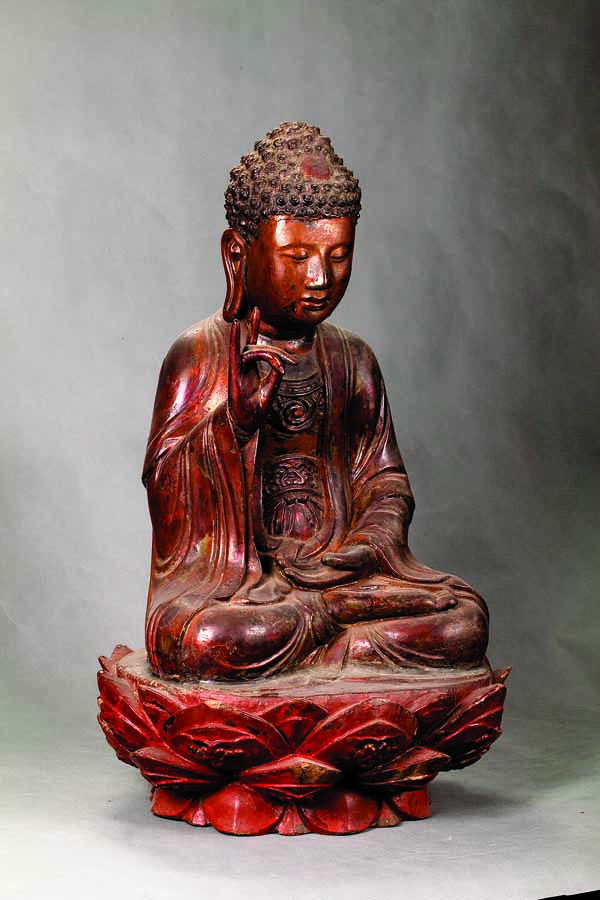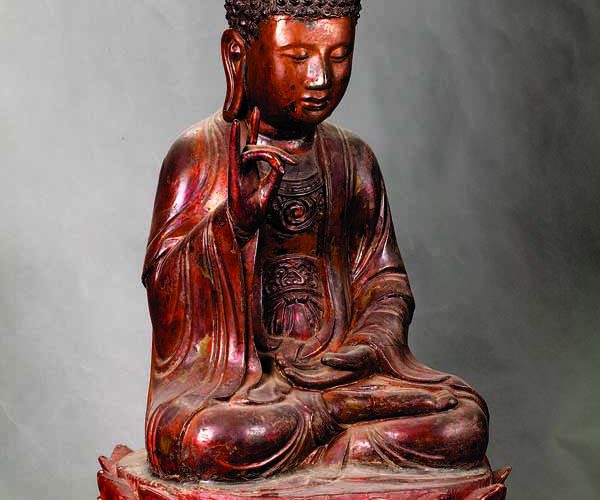(No.5, Vol.7,Oct-Nov 2017 Vietnam Heritage Magazine)
Sakyamuni Buddha

Mõ, a wooden bell usually seen in a pagoda for praying

Nghê, a creature with a lion-like head, a long tail and a dog-like body
Living in the rain forests of Southeast Asia, Vietnamese are well-connected to the botanical world. Evolving out of the Stone Age, perhaps to the ancient Viet people, wood was the next natural and suitable choice of material to use for various purposes. Through generations, wood became one of the most popular materials for making items that serve everyday life and spiritual needs of humans. Our ancestors’ skillful hands and refined sense of beauty have created a vast amount of wooden works that are still being used in households, venerated worship places, or in solemn former royal palaces all over the country.
The Vietnam National Museum of History currently holds a large and diverse collection of lacquered wood works which cover the whole span of the history of the founding and development of the country. These invaluable relics are proof of Vietnam’s age-old tradition of wood carving, lacquering and gilding crafts. Archeologists have found countless lacquered wood works, unmistakably locally made, in ancient graves in Viet Khe (Hai Phong Province), Chau Can (Hanoi), Duong Du, Xuan La, Minh Duc, Chau Son, and many other places. Many boat-shaped coffins, ironwood pillars, metal tools and weapons have also been found in Dong Son vestige sites. That means wood has been used by Vietnamese in matters of peace and war, life and death, work and worship since very early ages.
Along with ruling dynasties and spiritual life, wood carving, lacquering and gilding crafts have been increasingly prospering in our country. Historical records show that majestic palaces were all lacquered and gilded under the Dinh and Early Le Dynasties. Under the Ly Dynasty, temples and palaces were also decorated with glorious lacquered and gilded woodwork. The crafts most flourished under the Le and Nguyen Dynasties (17th to early 20th Centuries.) This cultural heritage is being respected and honored in the permanent exhibition entitled ‘Red and gold – A collection of lacquered and gilded woodwork’, which showcases a select part of the vast amount of woodwork collected, studied and maintained by the Vietnam National Museum of History in decades.
Honoring these relics, we show our admiration for ancient masters who spared no time and hardship to create invaluable works of art and transfuse their soul into wood, lacquer and gold, in order to engrave their heartfelt message for future generations about the traditions of nurturing love and gratitude to the country, to its builders and defenders and to the ancestors, and about the perpetual aspiration for a long and happy life for everyone. Our forefathers’ life philosophy, aesthetical mind and dexterity helped express historical and cultural values, customs and religious beliefs of the Viet people.
Among the artifacts preserved, the category of worshiped statues and altar utensils is the most numerous. The statues include those of Three Era Buddhas, Amit?bha, Avalokite?vara Bodhisattva, Newborn Shakyamuni, Bodhidharma, and The Sacred Mother. The altar utensils include incense tables, altars, worship chamber, worship beds, tablets, boxes of conferment letter, jars, vases, weapon racks, parallel sentence and motto boards, intricately decorated with classical themes of supernatural four, precious four, flowers, birds, and calligraphic designs.
These concrete, real items helped the museum staff to recreate lively scenes of spiritual activities. Here is a village pagoda with an altar of Three Era Buddhas, there is a temple or shrine with tablets of the tutelary god or an ancestral altar. A religious procession with eight-pole palanquin or a village festive day in an idyllic country side; everything can be reenacted within the National Museum of History.
Additionally, the topical exhibition also reserves a small space to introduce the wood sculpture carving trade village Son Dong and the lacquering, gold and silver laminating and gilding trade village Kieu Ky.
Son Dong (Hoai Duc – Hanoi) is a thousand-year old trade village specializing in carving wooden statues and worship utensils. Son Dong is most famous in imitating antiques to serve refurbishing temples, pagodas, shrines, historical and cultural vestige sites all over the country. The golden hands of talented Son Dong artisans have created highly sophisticated pieces of art work. With regard toKieu Ky village, the skill of its masters and strictly observed a 40-stage procedure of gold and silver processing make wooden statues, parallel sentences and horizontal motto boards, shine splendidly. These two trade villages used to be very prosperous. Having gone through ups and downs of history in recent years due to the resurgence of religious activities, the villages are having their Renaissance. Coming to Son Dong and Kieu Ky today, we can witness firsthand the procedures of wood carving, lacquering and gilding conducted under the merry symphony of saws, hammers and chisels resounding all around.
In Vietnam, wood processing in general and carving, lacquering and gilding in particular are a cherished cultural heritage that has been passed down through generations and has left for us an enormous amount of inheritance. This time around, our exhibition will not only pay tribute to traditional handicrafts as part of the nation’s cultural cream, but also help the public to better understand artifact collection, and as a result, to raise awareness about preservation, upholding and further enriching the values of national history, culture and arts.

